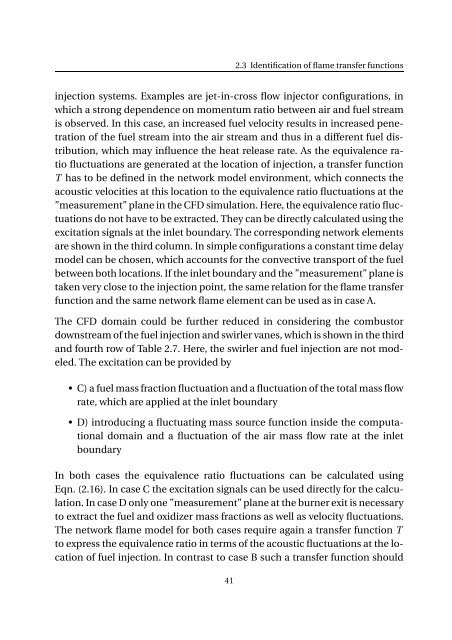Impact of fuel supply impedance and fuel staging on gas turbine ...
Impact of fuel supply impedance and fuel staging on gas turbine ...
Impact of fuel supply impedance and fuel staging on gas turbine ...
You also want an ePaper? Increase the reach of your titles
YUMPU automatically turns print PDFs into web optimized ePapers that Google loves.
2.3 Identificati<strong>on</strong> <str<strong>on</strong>g>of</str<strong>on</strong>g> flame transfer functi<strong>on</strong>s<br />
injecti<strong>on</strong> systems. Examples are jet-in-cross flow injector c<strong>on</strong>figurati<strong>on</strong>s, in<br />
which a str<strong>on</strong>g dependence <strong>on</strong> momentum ratio between air <str<strong>on</strong>g>and</str<strong>on</strong>g> <str<strong>on</strong>g>fuel</str<strong>on</strong>g> stream<br />
is observed. In this case, an increased <str<strong>on</strong>g>fuel</str<strong>on</strong>g> velocity results in increased penetrati<strong>on</strong><br />
<str<strong>on</strong>g>of</str<strong>on</strong>g> the <str<strong>on</strong>g>fuel</str<strong>on</strong>g> stream into the air stream <str<strong>on</strong>g>and</str<strong>on</strong>g> thus in a different <str<strong>on</strong>g>fuel</str<strong>on</strong>g> distributi<strong>on</strong>,<br />
which may influence the heat release rate. As the equivalence ratio<br />
fluctuati<strong>on</strong>s are generated at the locati<strong>on</strong> <str<strong>on</strong>g>of</str<strong>on</strong>g> injecti<strong>on</strong>, a transfer functi<strong>on</strong><br />
T has to be defined in the network model envir<strong>on</strong>ment, which c<strong>on</strong>nects the<br />
acoustic velocities at this locati<strong>on</strong> to the equivalence ratio fluctuati<strong>on</strong>s at the<br />
”measurement” plane in the CFD simulati<strong>on</strong>. Here, the equivalence ratio fluctuati<strong>on</strong>s<br />
do not have to be extracted. They can be directly calculated using the<br />
excitati<strong>on</strong> signals at the inlet boundary. The corresp<strong>on</strong>ding network elements<br />
are shown in the third column. In simple c<strong>on</strong>figurati<strong>on</strong>s a c<strong>on</strong>stant time delay<br />
model can be chosen, which accounts for the c<strong>on</strong>vective transport <str<strong>on</strong>g>of</str<strong>on</strong>g> the <str<strong>on</strong>g>fuel</str<strong>on</strong>g><br />
between both locati<strong>on</strong>s. If the inlet boundary <str<strong>on</strong>g>and</str<strong>on</strong>g> the ”measurement” plane is<br />
taken very close to the injecti<strong>on</strong> point, the same relati<strong>on</strong> for the flame transfer<br />
functi<strong>on</strong> <str<strong>on</strong>g>and</str<strong>on</strong>g> the same network flame element can be used as in case A.<br />
The CFD domain could be further reduced in c<strong>on</strong>sidering the combustor<br />
downstream <str<strong>on</strong>g>of</str<strong>on</strong>g> the <str<strong>on</strong>g>fuel</str<strong>on</strong>g> injecti<strong>on</strong> <str<strong>on</strong>g>and</str<strong>on</strong>g> swirler vanes, which is shown in the third<br />
<str<strong>on</strong>g>and</str<strong>on</strong>g> fourth row <str<strong>on</strong>g>of</str<strong>on</strong>g> Table 2.7. Here, the swirler <str<strong>on</strong>g>and</str<strong>on</strong>g> <str<strong>on</strong>g>fuel</str<strong>on</strong>g> injecti<strong>on</strong> are not modeled.<br />
The excitati<strong>on</strong> can be provided by<br />
• C) a <str<strong>on</strong>g>fuel</str<strong>on</strong>g> mass fracti<strong>on</strong> fluctuati<strong>on</strong> <str<strong>on</strong>g>and</str<strong>on</strong>g> a fluctuati<strong>on</strong> <str<strong>on</strong>g>of</str<strong>on</strong>g> the total mass flow<br />
rate, which are applied at the inlet boundary<br />
• D) introducing a fluctuating mass source functi<strong>on</strong> inside the computati<strong>on</strong>al<br />
domain <str<strong>on</strong>g>and</str<strong>on</strong>g> a fluctuati<strong>on</strong> <str<strong>on</strong>g>of</str<strong>on</strong>g> the air mass flow rate at the inlet<br />
boundary<br />
In both cases the equivalence ratio fluctuati<strong>on</strong>s can be calculated using<br />
Eqn. (2.16). In case C the excitati<strong>on</strong> signals can be used directly for the calculati<strong>on</strong>.<br />
In case D <strong>on</strong>ly <strong>on</strong>e ”measurement” plane at the burner exit is necessary<br />
to extract the <str<strong>on</strong>g>fuel</str<strong>on</strong>g> <str<strong>on</strong>g>and</str<strong>on</strong>g> oxidizer mass fracti<strong>on</strong>s as well as velocity fluctuati<strong>on</strong>s.<br />
The network flame model for both cases require again a transfer functi<strong>on</strong> T<br />
to express the equivalence ratio in terms <str<strong>on</strong>g>of</str<strong>on</strong>g> the acoustic fluctuati<strong>on</strong>s at the locati<strong>on</strong><br />
<str<strong>on</strong>g>of</str<strong>on</strong>g> <str<strong>on</strong>g>fuel</str<strong>on</strong>g> injecti<strong>on</strong>. In c<strong>on</strong>trast to case B such a transfer functi<strong>on</strong> should<br />
41
















